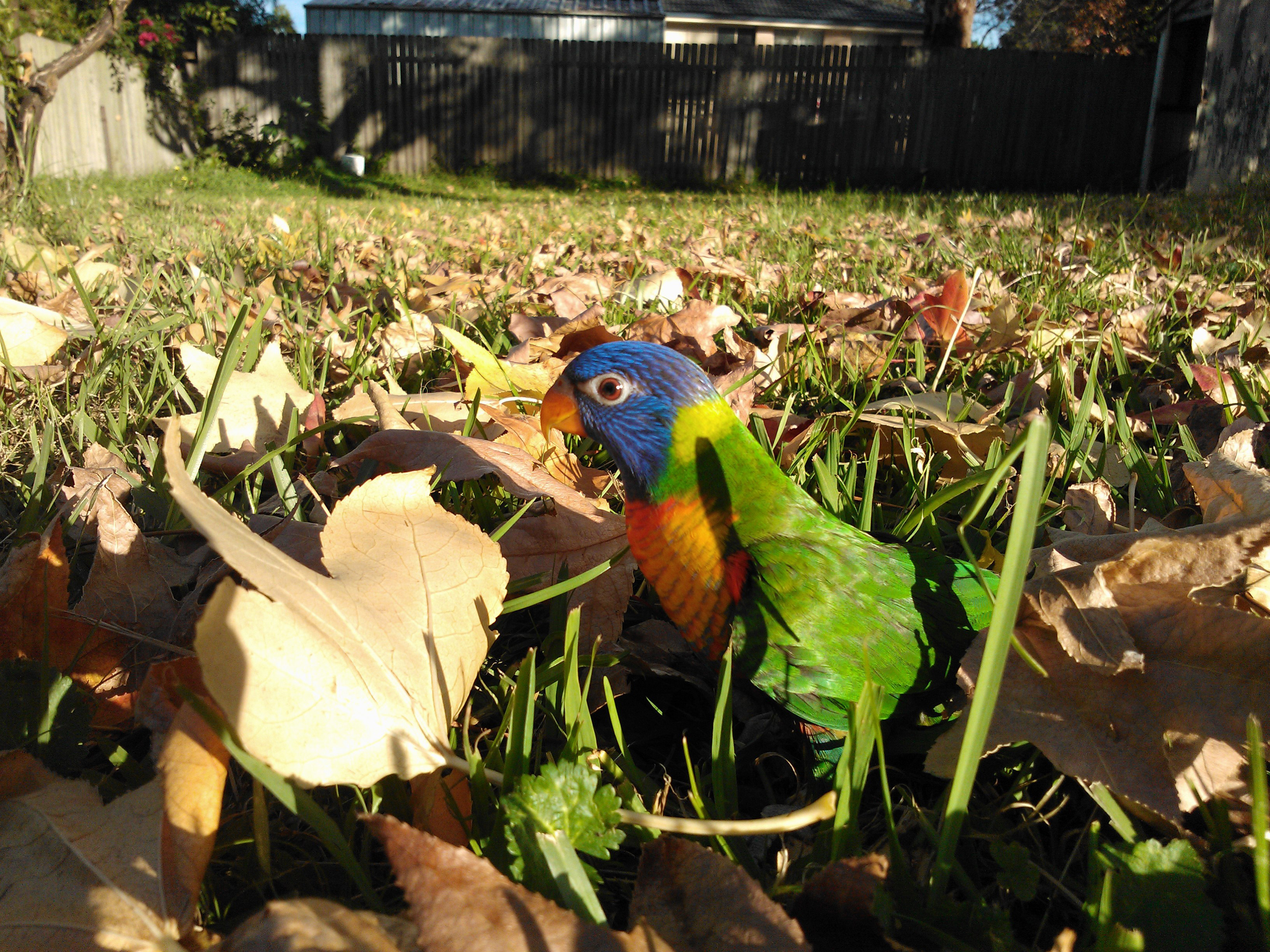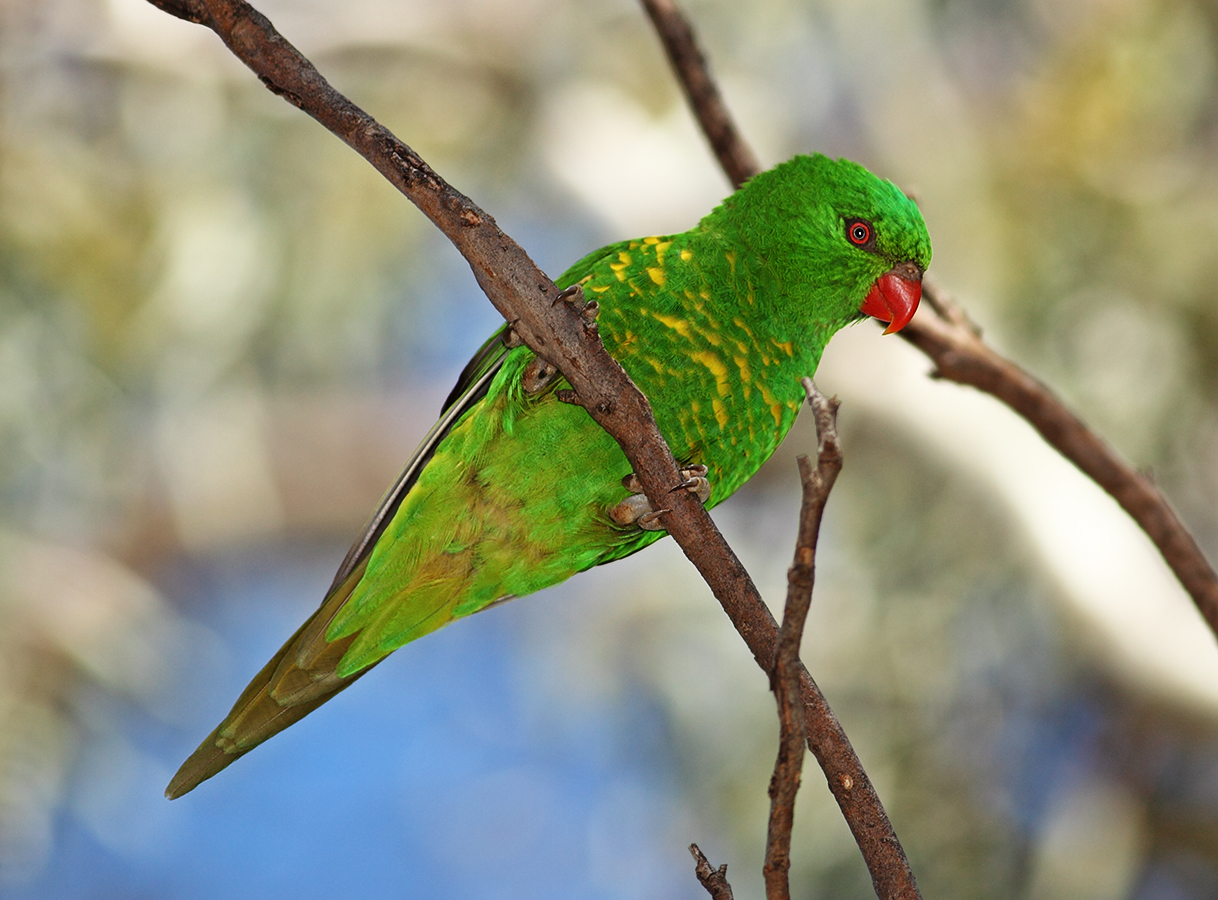|
Trichoglossus
''Trichoglossus'' is a genus of Lories and lorikeets, lorikeet in the Psittaculidae or true parrot superfamily. The genus is distributed widely through Australia, Wallacea and Melanesia, with outliers in the Philippines and Micronesia. Members of the genus are characterised by barring, sometimes prominently, on the upper breast. Taxonomy The genus ''Trichoglossus'' was introduced in 1826 by the English naturalist James Francis Stephens. The name combines the Ancient Greek ''thrix'' meaning "hair" and ''glōssa'' meaning "tongue". The type species was subsequently designated as the coconut lorikeet. Following the publication of a molecular phylogenetic study of the lorikeets in 2020, three species were moved from ''Trichoglossus '' to the newly erected genus ''Saudareos''. These were the Mindanao lorikeet, the ornate lorikeet and the Sula lorikeet (formerly the citrine lorikeet). Species The genus contains ten species: ''Trichoglossus'' sensu lato The Clem ... [...More Info...] [...Related Items...] OR: [Wikipedia] [Google] [Baidu] |
Trichoglossus Moluccanus
The rainbow lorikeet (''Trichoglossus moluccanus'') is a species of parrot found in Australia. It is common along the eastern states of Australia, eastern seaboard, from northern Queensland to South Australia. Its habitat is rainforest, coastal bush and woodland areas. Six taxa traditionally listed as subspecies of the rainbow lorikeet are now treated as separate species (see rainbow lorikeet#Taxonomy, ''Taxonomy''). Rainbow lorikeets have been introduced species, introduced to Perth, Western Australia;ScienceWA Rainbow lorikeet joins Perth pest list Tasmania; Auckland, New Zealand; [...More Info...] [...Related Items...] OR: [Wikipedia] [Google] [Baidu] |
Rainbow Lorikeet
The rainbow lorikeet (''Trichoglossus moluccanus'') is a species of parrot found in Australia. It is common along the eastern seaboard, from northern Queensland to South Australia. Its habitat is rainforest, coastal bush and woodland areas. Six taxa traditionally listed as subspecies of the rainbow lorikeet are now treated as separate species (see ''Taxonomy''). Rainbow lorikeets have been introduced to Perth, Western Australia;ScienceWA Rainbow lorikeet joins Perth pest list ; , |
Coconut Lorikeet
The coconut lorikeet (''Trichoglossus haematodus''), also known as the green-naped lorikeet, is a parrot in the family Psittaculidae. Seven species of lorikeets now recognised were once lumped together under ''Trichoglossus haematodus''. Taxonomy In 1758, English naturalist George Edwards (naturalist), George Edwards described this species as the red-breasted parrakeet in his work ''Gleanings of Natural History''. He had obtained a stuffed specimen from a China warehouse in London, that had come from the East Indies. "It is a parrakeet, equal to any I have seen for beauty; and I believe hath never been described or figured until now." In 1760 the French zoologist Mathurin Jacques Brisson included a description of the coconut lorikeet in his ''Ornithologie'' based on a specimen collected on the island of Ambon Island, Ambon in Indonesia. He used the French name ''La perruche variée d'Amboine'' and the Latin name ''Psittaca amboinensis varia''. The two stars (**) at the start of th ... [...More Info...] [...Related Items...] OR: [Wikipedia] [Google] [Baidu] |
Lories And Lorikeets
Loriini is a tribe of small to medium-sized arboreal parrots characterized by their specialized brush-tipped tongues for feeding on nectar of various blossoms and soft fruits, preferably berries. The species form a monophyletic group within the parrot family Psittaculidae. The group consists of the lories and lorikeets. Traditionally, they were considered a separate subfamily (Loriinae) from the other subfamily (Psittacinae) based on the specialized characteristics, but recent molecular and morphological studies show that the group is positioned in the middle of various other groups. They are widely distributed throughout the Australasian region, including south-eastern Asia, Polynesia, Papua New Guinea, Timor Leste and Australia, and the majority have very brightly coloured plumage. Etymology The word "lory" comes from the Malay ''lūri'', a name used for a number of species of colourful parrots. The name was used by the Dutch writer Johan Nieuhof in 1682 in a book describing h ... [...More Info...] [...Related Items...] OR: [Wikipedia] [Google] [Baidu] |
Trichoglossus Euteles
The olive-headed lorikeet (''Trichoglossus euteles''), also called the perfect lorikeet, is a species of parrot in the family Psittaculidae. It is found in forest, woodland and cultivated areas on Timor and smaller nearby islands. Description The olive-headed lorikeet is a mainly green parrot about 24 cm (9.5 in) long. It has an olive coloured head which is demarcated by a green collar. Its beak is orange-red, its irises are red, and its legs are grey. The male and female have an identical external appearance. Juveniles have a slightly greener head, a brown beak, and brown irises.Forshaw (2006). plate 13. Taxonomy The taxonomic name of the olive-headed lorikeet is ''Trichoglossus euteles'' (Temminck, 1835). They are part of the genus of lorikeet ''Trichoglossus''. They also belong in the subfamily Loriinae of the family Psittaculidae. Habitat and Distribution Adonara and Lembata are medium to large volcanic islands located off the eastern tip of Flores, in East Nusa T ... [...More Info...] [...Related Items...] OR: [Wikipedia] [Google] [Baidu] |
Trichoglossus Rubritorquis
The red-collared lorikeet (''Trichoglossus rubritorquis'') is a species of parrot found in wooded habitats in northern Australia (north-eastern Western Australia, northern Northern Territory and far north-western Queensland). It was previously considered a subspecies of the rainbow lorikeet, but today most major authorities consider them as separate species.Dickinson, E. C. (editor) (2003). ''The Howard and Moore Complete Checklist of the Birds of the World.'' 3d edition. Christopher Helm. No other member of the rainbow lorikeet group has an orange-red collar over the nape. Every year at the end of the dry season in Darwin, many of them display symptoms of apparent drunkenness. What causes this condition is unclear, though it is thought to be most likely due to a seasonal virus. Intoxication with fermented nectar has been ruled out. Taxonomy Nicholas Aylward Vigors and Thomas Horsfield described the red-collared lorikeet in 1827. The species name is derived from the Latin w ... [...More Info...] [...Related Items...] OR: [Wikipedia] [Google] [Baidu] |
Trichoglossus Chlorolepidotus
The scaly-breasted lorikeet (''Trichoglossus chlorolepidotus'') is an Australian lorikeet found in woodland in eastern Australia. The common name aptly describes this bird, which has yellow breast feathers broadly edged with green that look like scales. Taxonomy The scaly-breasted lorikeet was first described by German zoologist Heinrich Kuhl in 1820. Other names this bird is known by include the gold and green lorikeet, greenie, green lorikeet, green and yellow lorikeet, green keet, green parrot, green leek, and green leaf. It is often colloquially referred to as a "scaly". Its specific epithet is derived from the Ancient Greek root ''khlōros'' 'green, yellow', and ''lepidōtos'' 'scaly'. Description The scaly-breasted lorikeet is about long.Forshaw (2006). plate 13. The crown and sides of head are emerald-green slightly tinged with blue, while the feathers of the back of the neck and throat and breast are yellow, broadly edged with green, giving scaly appearance. The tail is ... [...More Info...] [...Related Items...] OR: [Wikipedia] [Google] [Baidu] |
Trichoglossus Rosenbergii
The Biak lorikeet (''Trichoglossus rosenbergii''), also known as Rosenberg's lorikeet, is a parrot in the family Psittaculidae. Formerly lumped in with ''Trichoglossus haematodus'', it is endemic to the twin islands of Biak and Superiori in the Papua province of Indonesia. Habitat As a newly separated species, specific information is scarce. It is assumed to be similar to other Trichoglossus parakeets in preferring lowland forest including secondary growth and plantations. Threats On Biak, forest is under heavy pressure from logging and subsistence farming Subsistence agriculture occurs when farmers grow crops on smallholdings to meet the needs of themselves and their families. Subsistence agriculturalists target farm output for survival and for mostly local requirements. Planting decisions occ .... Trapping for trade does occur, but how much that affects the species is uncertain. Its population is believed to be decreasing, with fewer than 10,000 mature individuals in the ... [...More Info...] [...Related Items...] OR: [Wikipedia] [Google] [Baidu] |
Saudareos
''Saudareos'' is a genus of parrot in the family Psittaculidae. Species identified within this genus include lorikeets from the Philippines and Indonesia. Taxonomy The genus ''Saudareos'' was introduced in 2020 for a clade of lorikeets that form a sister clade to ''Eos''. The type species is the ornate lorikeet. The genus name combines the Indonesian language "saudara" meaning "sister" with the genus name ''Eos''. The genus contains three species which were formerly assigned to ''Trichoglossus ''Trichoglossus'' is a genus of Lories and lorikeets, lorikeet in the Psittaculidae or true parrot superfamily. The genus is distributed widely through Australia, Wallacea and Melanesia, with outliers in the Philippines and Micronesia. Members ...'' and one that was assigned to '' Psitteuteles. The genus contains the following five species: References Bird genera {{parrot-stub ... [...More Info...] [...Related Items...] OR: [Wikipedia] [Google] [Baidu] |
Trichoglossus Rubiginosus
The Pohnpei lorikeet (''Trichoglossus rubiginosus''), known as serehd in Pohnpeian, is a species of parrot in the family Psittaculidae. It is endemic to the island of Pohnpei and the nearby Ant Atoll in Micronesia. Historically the species also occurred on Namoluk Atoll near Chuuk, and the species may once have had a wider distribution throughout Micronesia than it does today.Steadman D, (2006). ''Extinction and Biogeography in Tropical Pacific Birds'', University of Chicago Press. Description The Pohnpei lorikeet is long and weights around . Its plumage is mainly reddish-maroon with vague approximately transverse striations of darker maroon. The head a slightly darker maroon. The flight feathers and tail are olive-yellow. Its legs are grey. The male has an orange beak and yellow-orange irises, while the female has a yellow beak and light grey irises. The juveniles have brown beaks and brown irises.Forshaw (2006). plate 13. Habitat and behaviour Its natural habitat is tropic ... [...More Info...] [...Related Items...] OR: [Wikipedia] [Google] [Baidu] |
Ornate Lorikeet
The ornate lorikeet (''Saudareos ornata''), sometimes named the ornate lory, is a species of parrot in the family Psittaculidae. It is endemic to the Sulawesi archipelago in Indonesia.Coates, B. J., & K. D. Bishop (1997). ''A Guide to the Birds of Wallacea.'' Dove Publications Pty. Ltd. It is found in forest, woodland, mangrove and plantations, and is locally common. Taxonomy The ornate lorikeet was formally described by the Swedish naturalist Carl Linnaeus in 1758 in the tenth edition of his ''Systema Naturae'' under the binomial name ''Psittacus ornatus''. Linnaeus based his description of the "Lory Parrakeet" that had been described and illustrated in 1751 by George Edwards in his "A Natural History of Uncommon Birds". Linnaeus mistakenly specified the location as "America" although Edwards had stated that the bird had come from the "East Indies" (actually the Indonesian island of Sulawesi). The ornate lorikeet was formerly placed in the genus ''Trichoglossus'' but was mov ... [...More Info...] [...Related Items...] OR: [Wikipedia] [Google] [Baidu] |





